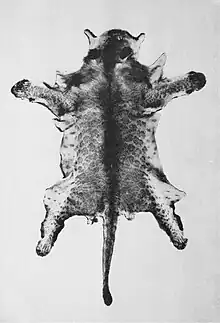Marozi
The marozi is a name given to a type of spotted feline sighted in Kenya in the early 20th century. It was variously theorized by zoologists of the time to be a distinct race of lion, an adult lion that retained its juvenile spots, or an entirely distinct species of feline. A scientific name, Panthera leo maculatus, was given, but the marozi was not confirmed to be a species or subspecies of its own, though skins of hunted specimens fitting the description do exist.
Claims

Though there were local East African legends of spotted lions, the first sighting documented by westerners was from Colonel Richard Meinertzhagen in 1903, who discussed seeing dark lions with rosette-like markings in the mountains of Kenya. Meinertzhagen had previously heard of the spotted lions, but it was likely dismissed as a native myth.[1]
Another incident was in 1931, when a white farmer, Michael Trent, shot and killed two individuals, a male and a female, in the Aberdare mountains at an elevation of 10,000 feet (3,000 m). The unusual spotted markings on what seemed to be smallish adult lions prompted interest from the Nairobi Game Department; they were from adult lions and yet had prominent spots that are typical only of cubs, and the male lion's mane was insignificant. The department lacked sufficient skeletal evidence to definitively prove the species or age.[1]
Two years later, explorer Kenneth Gandar-Dower headed an expedition into the region in an attempt to capture or kill more specimens. He returned with only circumstantial evidence: three sets of tracks found at a similar elevation as Trent's lions (10,000–12,500 feet or 3,000–3,800 metres). They were believed to have been left by individuals that were tracking a herd of buffalo during a hunt, ruling out the possibility of the marozi being cubs. Gandar-Dower noted that while some adult lions did keep their rosettes, such lions did not have them to the same degree as the pelts.[1][2]
There were other sightings around the same time:
- Four animals sighted by Game Warden Captain R. E. Dent in the Aberdare Mountain region at an elevation of 10,000 feet (3,000 m).[1]
- A pair sighted on the Kinangop Plateau by G. Hamilton-Snowball at an elevation of 11,500 feet (3,500 m). They were shot at, but escaped.[1]
in 1950, The Field published a discourse by W. Robert Foran, who was skeptical of the existence of a race of such animals, though he had shot adult lions fitting the description himself in 1906.[3] In 1963, zoologist Charles Albert Walter Guggisberg claimed that there is no reliable evidence for the marozi, despite the existence of the skin pictured above, saying "to this day nobody has been able to produce any proof of its existence".[4]
See also
References
- Hartwell, Sarah. "MUTANT BIG CATS - SPOTTED LIONS". Messybeast. Retrieved 2023-07-30.
- Gandar-Dower, Kenneth (1937). The Spotted Lion. William Heinemann Ltd. – via HathiTrust Digital Library.
- Foran, W. Robert (1950). The Legendary Spotted Lion. The Field.
- Guggisberg, Charles Albert Walter (1963). Simba, the Life of the Lion. Chilton Books. p. 50.